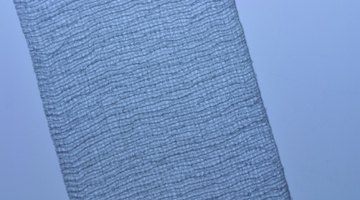Cheesecloth Vs. Muslin
Cheesecloth and muslin are both loose-weaved, inexpensive fabrics with a natural color. The choice between the two during fabrication will depend on the actual use, such as culinary or cooking projects, garment construction or theater backdrops.

The weave for both makes it appropriate for creating clothing for hot climates and for allowing liquids to drain from food products, such as when thickening cheeses or straining sauces.
Cheesecloth Grades
Cheesecloth is found in many different grades of weave construction, which makes it useful for a variety of applications for cooking and cheese making. The finer the weave construction, the more particles it will filter out of the product. The different grades of weave come in very loose Number 10 grade, or 20 by 12 threads per inch, all the way to fine Number 90 grade, or 44 by 36 per inch. For garment construction and sewing, the finer weaves are used to withstand fittings. Cheesecloth is found in both unbleached natural colors and bleached white.
Muslin Weave
Muslin fabric is finer than cheesecloth and is the choice for creating garments to wear in very hot or humid climates. While it does wrinkle during wearing, loose pants and dresses are airy and lightweight. Different thread counts are also available for muslin fabrics. With its finer construction weave, this fabric is often also used for theater backdrops since it can handle paint and pen art well and is easily dyed to create any shade needed. Since it is inexpensive, muslin fabric is also used to make a muslin, or a sewn draft, of an actual pattern. Muslin fabric is available in both natural unbleached colors and bleached white.
Strength Differences
The strength differences lie in the actual weave of the fabrics. Cheesecloth is available in very loose weave making it a very weak fabric when used by itself. When used in culinary applications such as for straining, it is double or triple folded to prevent the fabric from unraveling as the liquid is passed through it. For garment construction, choose a weave from either one with a higher thread count making it suitable for multiple wearings.
The Bottom Line
Cheesecloth and muslin are both relatively inexpensive fabrics that are used in a wide variety of applications. Both are easily dyed and can be purchased by the bolt for large projects. Cheesecloth is readily available in all forms and is the choice for chefs to strain stocks and jellies and for cheese making. With the wide choice of weaves, users can choose the exact fineness of cheesecloth they need for the project. Muslin fabrics have a finer weave, making it a stronger and better choice for actual wearable garments because it will handle multiple washings and wearings.
The Drip Cap
- Cheesecloth and muslin are both loose-weaved, inexpensive fabrics with a natural color.
- The weave for both makes it appropriate for creating clothing for hot climates and for allowing liquids to drain from food products, such as when thickening cheeses or straining sauces.
- Muslin fabric is finer than cheesecloth and is the choice for creating garments to wear in very hot or humid climates.
- Muslin fabric is available in both natural unbleached colors and bleached white.
References
Writer Bio
Renee Shelton is publisher of the periodical, Pastry Sampler Journal, and is editor and contributing writer to several niche blogs. Her personal webpages have been referenced in numerous cookbooks. When she isn't writing about food, you'll find her hunting down historical cookbooks at swap meets.
Photo Credits
- Photos.com/Photos.com/Getty Images
- Photos.com/Photos.com/Getty Images
More Articles



